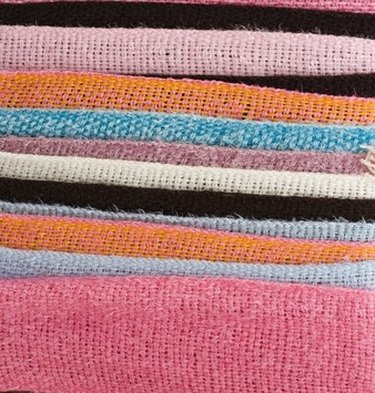Things You'll Need
Loosely woven fabric
Scissors
Rotary cutter (optional)
Cutting mat (if using rotary cutter)
Ruler
Fabric pencil or tailor's chalk
Sewing machine (optional)
Sewing thread and needle

When you fringe the edge of fabric, you unravel it. It's that simple. Also known as "self-fringing," the process involves pulling threads one at a time from the weave of the fabric in one direction so the remaining fibers hang loose. Wool, linen and other loosely woven fabrics work best for fringing. To determine if a fabric will fringe well, pinch the edge with your fingernails and pull at the weave. If the threads separate easily, you'll get good results with self-fringing that fabric.
Step 1
Straighten the edge of the fabric you want to fringe. If using scissors, position the ruler and mark a straight line down the edge of the fabric with fabric pencil or tailor's chalk. Cut along the drawn line. If using a rotary cutter and cutting mat, lay the edge of the fabric on the cutting mat. Position the ruler over the fabric so the uneven parts of the fabric edge extend beyond the ruler. Make sure the edge of the ruler is aligned with a cutting line on the mat. Hold the ruler firmly with one hand while rolling the rotary cutter along the ruler. Move the rotary cutter away from you rather than toward you. Discard the trimmed pieces of fabric. Repeat for each fabric edge that needs to be straightened.
Video of the Day
Step 2
Determine the length of fringe you want. Measure that distance from the edge of the fabric and draw a line using the ruler and fabric pencil or tailor's chalk. Do this for each side of the fabric you want to fringe. The line should run parallel to the fabric edge, extending all the way around the fabric if the entire piece is to be fringed.
Step 3
Sew along the marked line. If using a machine, sew a narrow zigzag stitch along the line. If sewing more than one fabric edge, pivot at the corners and continue the zigzag stitch along the line. If you hand-sew the line, use a back stitch. If sewing more than one fabric edge, back stitch along the line to the corner. At the corner, bring the needle back up through the end of the final back stitch, turn the fabric and continue to stitch along the drawn line of the next edge. Repeat for each corner.
Step 4
Pull loose the top thread that runs parallel to the stitched line along one edge. This is the crosswise thread. Use the point of a sewing needle to loosen the thread if it's hard to separate from the weave. Gently extract the entire thread. This will produce a short fringe of loose threads that run perpendicular to the stitched line. These are the lengthwise threads. Continue to pull the crosswise threads one by one, revealing more and more fringe. Stop when you reach the stitched line. If fringing more than one fabric edge, finish pulling threads on one edge, then turn the fabric. At the corner, the crosswise threads of the previous edge become the lengthwise threads of this edge. Start with the top thread as before and pull each one until you reach the stitched line. Repeat for each edge.
Tip
If you're pulling threads along a long edge, such as for a tablecloth or skirt hem, you might find that the thread breaks before you've extracted it from the weave. Snip into the crosswise threads first to create shorter threads and reduce breakage. Be careful not to cut the lengthwise threads that create the fringe or snip into the sewn line.
Video of the Day